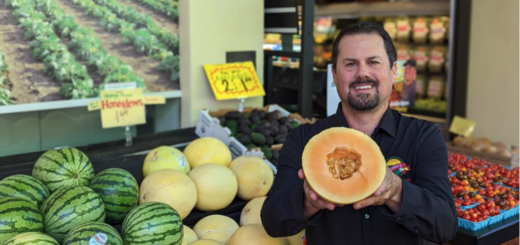Farm Focus: CHERIMOYA
Farm Focus: California-grown Cherimoya
The fruit that is “deliciousness itself!” – Mark Twain
By Robbie Sigona
 Have you heard of Cherimoya before? Describing this fruit can be difficult even though Cherimoyas have an almost cult-like status. Cherimoya happens to be part of the custard apple family, a name to which it is perfectly suited, even if that relationship is meaningless to most Americans. Some say it looks like a green apple with scales or a suit of armor, others say it resembles its Amazonian cousins, the soursop or guayabana which have a prickly-looking skin.
Have you heard of Cherimoya before? Describing this fruit can be difficult even though Cherimoyas have an almost cult-like status. Cherimoya happens to be part of the custard apple family, a name to which it is perfectly suited, even if that relationship is meaningless to most Americans. Some say it looks like a green apple with scales or a suit of armor, others say it resembles its Amazonian cousins, the soursop or guayabana which have a prickly-looking skin.
The skin of a cherimoya is not prickly, but it’s not smooth: most are covered with either bumps or dimples. Unlike its apple look-alike, however, the leathery greenish-brown skin is inedible, as are the numerous black seeds dispersed throughout the fruit. Its flesh has a custard-like texture that is pearly white, soft, silky smooth, and delicate; much as custard should be. The flavor of Cherimoya combines attributes of apple, passion fruit, banana, mango, and pineapple into a unique profile all of its own.
With this tropical flavor comparison, you may be surprised to learn these delicate fruits come to us from the Santa Barbara hills! It’s rare that you’ll see cherimoyas in big chain grocery stores as they’re more of a specialty item and are usually a bit on the expensive side as they are delicate fruits that have to be hand pollinated!
The Cherimoya is believed to be native to Ecuador, where it was originally discovered in the Inter-Andean valleys. In the late nineteenth century, it was brought to California, where it is now grown in the coastal and foothill regions of the southern part of the state. Sigona’s is currently carrying Bay variety Cherimoyas, which are typically light green, heart-shaped, approximately three to four inches long and about three to four inches wide.
Though Cherimoyas can be used to make a variety of desserts and drinks, this is a fruit that is typically eaten on its own and requires little embellishment. To access the creamy, white flesh, cut the Cherimoya in half lengthways and simply scoop it out with a spoon (as you would an avocado). Once the Cherimoya has been halved, we recommend squirting on a bit of lemon or lime juice to keep it from darkening (again, like an avocado or apple). Cherimoyas can also be peeled and cut into pieces or puréed and used in salsas, seafood dishes (such as this one from Sunset magazine’s February issue), mousses, dessert sauces, pie fillings or creamy drinks.
Cherimoya is particularly tasty after having been frozen – they become an amazing and completely natural alternative to ice cream! However, if you do wish to add a few additional flavors, Cherimoyas can also be used to make a unique milkshake or smoothie. Simply combine a frozen Cherimoya (again, be sure to remove the seeds first!) with your favorite milkshake or smoothie ingredients, mix in a blender, and you’ll have a delicious, creamy, and fruity frozen drink!
The relatively rare Cherimoya will be at Sigona’s through June and we always have numerous ripe fruits on hand for you to enjoy. There is nothing quite like sub-tropical fruit in February! Try a Cherimoya today and you won’t be disappointed.
Robbie Sigona’s Produce Tips: Cherimoya
- When selecting a Cherimoya, keep in mind that a ripe fruit will be heavy for its size and have a slight give (yet shouldn’t feel too soft or squishy).
- If ripe, Cherimoyas can be refrigerated for approximately four days and overripe fruit will turn noticeably brown.
- The Bay variety is a great eating variety, known for its sweeter/less-acidic flavor and juicy, creamy texture.
Robbie Sigona is our produce buyer. He works with local farmers and scours the market for the very best in fresh fruits and vegetables — some you won’t find anywhere else.












